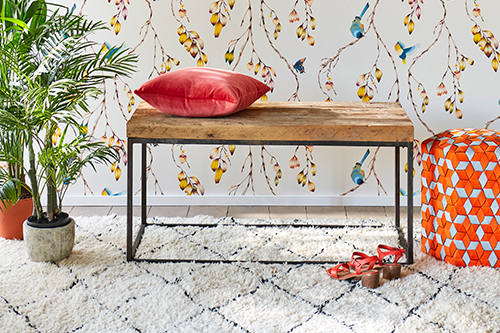Moroccan Berber and Beni Ourain Rugs
Posted by The Cowhiderugs.co.uk Team on 24th Feb 2018
Indigenous to North Africa, the Berbers are an ancient and distinct
ethnicity. They refer to
themselves as i-Mazigh-en –- a name whose meaning is shrouded in mystery
but may mean variations of "noble" or "free" people. They have been
producing some of the world's most beautiful rugs for thousands of years
with many design and motif variations being produced among the dozens
of Berber sub-tribes who still inhabit the slopes of the Atlas Mountains
and raise and shepherd sheep there.
The Berbers have spread out as well across a wide swathe of North
Africa, including in Libya and Algeria, and have founded many sizable
immigrant communities in countries in the West. However, the prized
Moroccan Berber rugs and Beni Ourain sub-tribe produced rug textiles are
mainly produced by Berber tribes living in the Atlas Mountains in
western North Africa. It is here where ancient practices of herding
sheep still persist and which provide the raw materials -– mainly
exceptionally high-quality wool -- that tribeswomen use in their rug
creations.
A happy confluence of factors has led to the present situation in which
members of the Berber tribes that produce these items have been enjoying
the benefits within the past 60 years or so of a vital injection of
economic stimulus -- engendered by the international explosion of
interest and desire for these unique textiles -- which is serving to
hugely improve many lives.
As Moroccan Berber rugs and the number of sub-tribes -– including Beni Ourain rug producers -- are becoming ever more prized by consumers and
interior decorators throughout the world, more and more people can enjoy
the sublime charms of these beautiful rugs while feeling good about
supporting the women who painstakingly hand-weave each and every rug,
including Beni Ourain rugs.
There are many distinct sub-tribes within the larger rug-producing
Berber contingent. This has naturally led to a wonderful and happy
diversity of styles, motifs, weaving methods, colours and uses for these
remarkable textiles. Some rugs are used as blankets or sleeping mats for
chilly alpine nights, as ceremonial rugs for celebrations or religious
rituals and as burial shrouds.
A deeply religious as well as superstitious people, the tribes-people who
labor on these rugs typically include designs that they believe will
bring good fortune or that will ward off malevolent spirits.
One of the foremost charms of Berber rugs and Ben Ourain rugs is
that each and every rug is a story in of itself -– the daughters and
women who carry on the increasingly lucrative practice incorporate
styles, designs, symbols, motifs and colors that are an extension of
their personality and life story. Berber women will use intimate details
from their life experience in the creating of their Berber rugs,
including by creating products that refer to themes bearing on birth,
nature, fertility, rural life and femininity.
While the market has exploded for these precious and versatile creations
-- to such a point where an industry in non-genuine, factory-produced
versions now exists -- the price-point on genuine, lovingly hand-made
rugs can be shocking to some. The market for vintage Moroccan Berber
rugs is another story altogether, with prices that can commonly soar
into the six-figure range.

